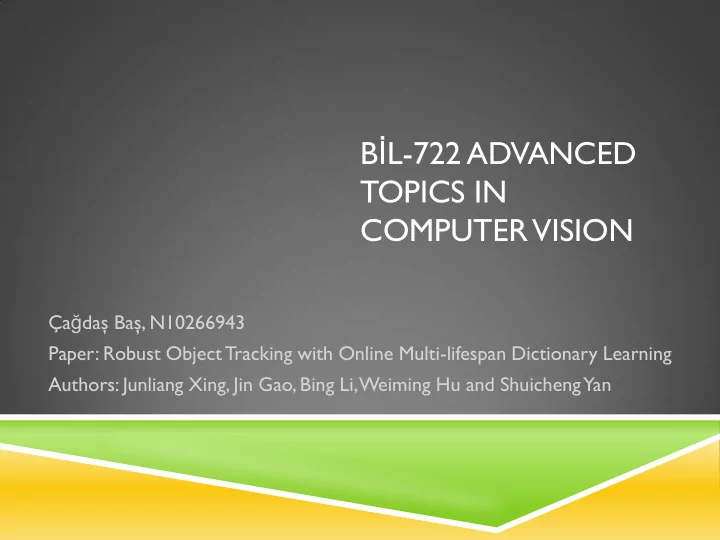

B İ L-722 ADVANCED TOPICS IN COMPUTER VISION Ça ğ daş Baş , N10266943 Paper: Robust Object Tracking with Online Multi-lifespan Dictionary Learning Authors: Junliang Xing, Jin Gao, Bing Li, Weiming Hu and Shuicheng Yan
TRACKING Images from: SUN Dataset
WHY IS TRACKING A DIFFICULT PROBLEM? Image noise and background clutter Illumination changes Clutter Motion
RELATED WORK There are three types of methods in general: Generative Methods 1. Eigentracker, meanshift tracker etc. MeanShift Tracker [1] Discriminative Methods 2. Ensemble tracker, MIL tracker etc. Sparse Learning Methods 3. This method MIL Tracker [2]
DıFFERENT STAGES OF TRACKıNG Designing good templates 1. Solving optimization problem efficiently 2. Updating the object template. 3. Many of the papers focus mainly on these two parts. Present methods use fixed templates or incremental template update.
WHAT IS SPARSE LEARNING? Represents an instance with a minimum set of dictionary elements. 2 + 𝜇 𝑑 1 min 𝑈𝑑 − 𝑧 2 𝑑 Find the sparse representation 𝑑 of 𝑧 in dictionary 𝑈
OVERALL APPROACH
TRACKING AS ONLINE DICTIONARY LEARNING Extract candidate regions 𝒵 Optimize a new object template (dictionary) by minimizing: 1 𝐸 ∗ = argmin 𝒵 𝑚(𝑧, 𝐸) 𝑑 𝑧∈𝒵 T emplate set is not predifined but learned in time.
ONLINE LEARNING ALGORITHM
MULTI-LIFESPAN DICTIONARY LEARNING
MULTI-LIFESPAN DICTIONARY LEARNING Sample starting frame changes the lifespan SLD, Short Life Span Dictionary is learned the samples extracted from only previous 1. frame. (Starting frame:t-1, Ending frame: t) Learned for best adaptation LLD, Short Life Span Dictionary is learned the samples extracted from all the frames 2. before current (Starting frame:1, Ending frame: t) Learned for robustness MLD, Short Life Span Dictionary is learned to balance short life span and long life 3. span (Starting frame:t/2, Ending frame: t) Balances trade-off between short term adaptive model and long term robust model. Final Template is: 𝐸 ∗ = {𝐸 𝑇 , 𝐸 𝑁 , 𝐸 𝑀 }
MULTI-LIFESPAN DICTIONARY LEARNING Learned examples of different life spanned dictionaries. Learned for best adaptation
BAYESIAN SEQUENTIAL ESTIMATION
PARTICLE FILTER Solving maximum posterior problem: 𝑦 𝑢 = argm𝑏𝑦 𝑞(𝑦 𝑢 |𝑧 1:𝑢 ) 𝑦 𝑢 means tracking. Use learned OMDL as observation model in Particle Filter: 𝑞 𝑧 𝑢 𝑦 𝑢 ∝ 𝑧 𝑢 𝑦 𝑢 𝑒 𝑧 𝑢 𝑦 𝑢 Generative: Fix Discriminative: dictionary and Exract negative optimize sparsity samples and optimize with labels
EXPERIMENTS Results compared with two different metric: Center location distance Overlap Ratio
EXPERIMENTS The template update method is evaluated firstly:
EXPERIMENTS Overall tracking error and precision:
EXPERIMENTS Speed Analysis:
VıSUAL RESULTS
THANKS D. Comaniciu and P . Meer. Kernel-based object tracking. TPAMI, 1. 25(5):564 – 77, 2003. B. Babenko, M. Yang, and S. Belongie. Robust object tracking with online 2. multiple instance learning.TPAMI, 33(8):1619 – 32, 2011.
Recommend
More recommend